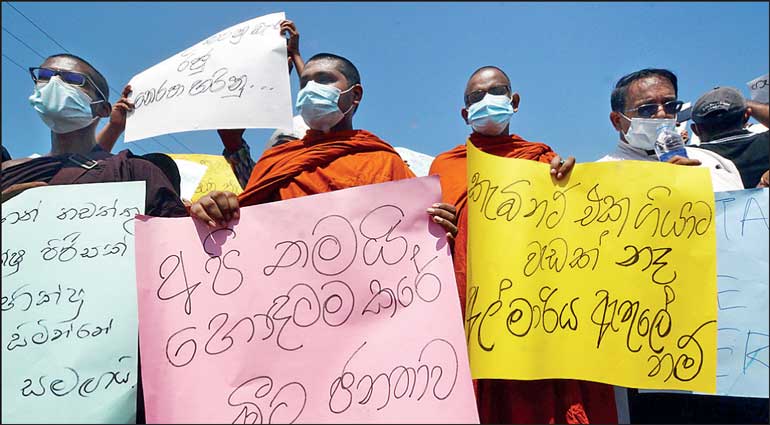Thursday Jan 15, 2026
Thursday Jan 15, 2026
Friday, 8 April 2022 00:00 - - {{hitsCtrl.values.hits}}

The situation is deadlocked: The People’s Movement demands that GR Go Home; GR will not go home; the Movement will not go home either
It is a Mexican standoff in the Indian Ocean. We are in a seemingly intractable situation. The finest political thinker of late modernity, Antonio Gramsci, described situations such as the current one by the term “catastrophic equilibrium…an equilibrium of forces tending towards catastrophe.”
term “catastrophic equilibrium…an equilibrium of forces tending towards catastrophe.”
We learn as school kids that an irresistible force meeting an immovable object, results in explosion.
The irresistible force is the “whole of society” civic movement, or simply, The Movement, which has gone to the root of the problem, and demands the removal of the autocrat. Though some argue that the ‘real’ problem is economic, those who are suffering most from the economic calamity understand that the country needs a fresh start; a reset for a re-boot.
Contrary to the neoliberal local pundits, The Hindu Editorial of 6 April refers to the Movement in Sri Lanka as a “political revolution”. The Movement has a simple, clear, strong slogan, Gota Go Home!
In the present case the immovable object is President Gotabaya Rajapaksa who refuses to resign in a catastrophic context in which any decent, self-respecting leader in any other country would have done so.
Instead, he is in a bunker mode, digging in, while the vast majority of the entirety of the populace is against him. He has only one source of political support, the bulk of the SLPP MPs. That reckoning does not include their vote base which seems to have evaporated. The SLPP cannot even muster a single mass demonstration anywhere in the country in support of Gotabaya Rajapaksa’s continued incumbency. At best they can muster a cluster of supporters to defend their residences.
The last card in President Gotabaya Rajapaksa’s deck is the military (together with the STF). I venture to suggest that it is also his ex-military brothers-in-arms, and a few members of the currently serving brass, who are reinforcing his decision to stay.
Taking in the present state of manifest, active discontent focused precisely at the President, discontent that extends to almost every Sri Lankan community on the planet including Estonia, is it at all possible for any rational mind to imagine a scenario in which President Gotabaya Rajapaksa can maintain the status quo, remain in office for the rest of his term? I certainly cannot.
Therefore, the situation is deadlocked: The People’s Movement demands that GR Go Home; GR will not go home; the Movement will not go home either.
Judging by the Chief Government Whip Johnston Fernando’s discourse, Camp GR seems to think that the status quo can hold simply by saying No, standing its ground and forcefully pushing back. The dangerous official discourse is already suggesting without supporting evidence that the Movement is driven by a dangerously subversive agenda of the JVP, which is of course the same lie that Minister Ananda Tissa de Alwis uttered in 1983, accusing the JVP of Black July and proscribing it, making inevitable the horrendous Southern Civil War of the late 1980s.
A military solution?
Voltaire said, “If we believe absurdities, we shall commit atrocities”. As the contemporary colloquialism goes, if you are a hammer, every problem looks like a nail.
For the military mindset of Gotabaya Rajapaksa and those closest to him, those he relies on, behind the Civic Movement is a violent revolutionary attempt by the JVP, i.e., a security threat. By ‘securitising’ a social, political and economic problem, the militarist GR bloc will inevitably arrive at a hyper-securitised, militaristic solution. There may be a military crackdown and an ensuing induction of the military into rulership.
Regular readers of my column may recall my alarm when in 2020 with the onset of COVID-19 and the scheduled parliamentary election, the hardliners of Team GR openly denounced elections, called for the parliament to be shut down, the postponement of elections for five years and worst of all, rule by the President with the Armed Forces. For the militarist Far-Right, that was Plan A, not Plan B. In the context of the challenge from the unarmed Civic Revolution, that Plan A which probably was shelved as Plan B, may now be dusted-off for implementation.
If activated, it may cause some temporary disruption, but will generate a far worse problem. Militarists may think that provoking the Movement into armed resistance will make it easier to destroy, but the Sri Lankan situation today is quite specific. The economy is collapsing and the only way for it to even begin to stop its deadfall is to put out a good news story of the President’s resignation and the departure of the Rajapaksas. Since that won’t happen, any repression of the vast protest Movement will only cause the economy to hit rock bottom because repression will trigger a general strike and an uprising.
When that resistance is bloodily suppressed, the economy will be wrecked, the ruler will have an angry populace of all social classes, races and religions, to rule over. Already, President Gotabaya Rajapaksa no longer has any “soft power”, that which Prof. Joseph Nye described as the power of a narrative to persuade and attract. He only retains “hard power”. If he deploys that hard power in the irreversible absence of soft power, he will lose every last shred of legitimacy, have to make an economy work, run a country, secure compliance from a bitter citizenry and survive a firestorm of global denunciation leading to sanctions.
Cumulatively it is a recipe for a violent revolution, waged mainly by youth from the working people and the older working people themselves, supported by an awakened educated youth and parents from the privileged classes. This time a guerrilla war will be sustainable in the countryside and the cities, eventually leading to an armed insurrection of the whole nation, and the bloody overthrow of the regime and the entire political, social and economic order. Think the overthrow of the Somoza oligarchy and the defeat of the National Guard (the military) by the Sandinistas of Nicaragua in 1979.
This scenario can be avoided, the outcome deflected. There is a way.
A political transition
The only meaningful discussion today is the discussion on a political transition.
Since the President will not resign, the parliament must become the engine of the transition, drawing its social power from the democratic Civic Movement and becoming the instrument of the collective political will of society.
Since President GR will not transition out, he must be transitioned down; downsized. Parliament can do that.
While the pressure must be kept up relentlessly and the struggle speeded up, peacefully escalated for the goal of Gota Go Home, the Parliament can cut the ground from under him, while he still sits in his Presidential chair. This is not by abolishing the Executive Presidency as the Leader of the Opposition suggested, because that would not secure the support of the SLFP and the all-important 40 dissidents, and would require a Referendum (notwithstanding Jayampathy Wickremaratne’s opinion).
The ‘abolition’ solution poses a more serious risk. Any student of democratic transitions knows that the armed forces must be brought on board or at least neutralised or else the hawks succeed in enlisting them to abort a peaceful democratic transition. If the Sri Lankan armed forces feel that the executive presidency is about to be abolished while provincial councils stand, thereby enfeebling the strong centre, a strong state, it will be more likely to intervene against society.
Shrink Gota
My solution is much more doable. Here I write not only as a political scientist and published author, but perhaps more pertinently, as a political scientist who as a Vice-President of the UNHRC, the Chairman of the ILO, and the Chairperson of the UN’s Durban Declaration against Racism, has of necessity gained considerable experience as a negotiator and consensus-builder (capable also of garnering majorities when compromise is impossible).
All Parliamentary parties should look at two texts: the 20th Amendment and the 19th. The 20th Amendment should be stripped of excessive powers. The 19th Amendment should be tweaked to avoid the disasters of the past. The methodology should not be to strive for a result which any one party is happy with. There should be no unnecessary wrangling. The methodology should be one that gets to the goal.
What should that goal ‘not’ be? It should not be the maximum agreement among a minimum number. Instead, the goal should be the minimum level of achievement of a maximum number in Parliament, so as to obtain a two-thirds majority in as short a time frame as possible (set a tight deadline; work continuously), to arrive at a solution before the regime sends in the tanks and there is blood running freely in the streets outside.
Once the 20th Amendment is downsized, the wholly legitimate objection of the Opposition to serving under an autocratic Gotabaya Rajapaksa would no longer be relevant. If the 19th Amendment is reset and rebooted, it should be possible to install an all-parties or multi-party interim/provisional administration. Such an administration can negotiate with the IMF to stabilise the economy and take the pressure off the people, while safeguarding the rights and living standards of the people.
Such an administration could also facilitate an early election at Presidential and parliamentary levels so the country can restart with a clean slate, as powerfully demanded by the people of Sri Lanka, and Sri Lankans around the world in the Diaspora, speaking with one voice, effectively exercising their sovereignty as enshrined in the Constitution.